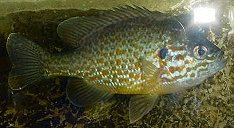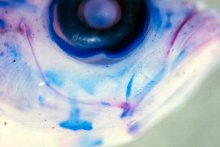| Research Topics for Jeff Arendt |
|
| Evolutionary Ecology of Growth Rate |
|
| My primary interest is in the evolutionary ecology of growth
rate and body size. It has become increasingly clear that growth rates (increase
in size per unit time) are optimized for local conditions rather than always
being maximized so that individuals always grow as fast as physiologically
possible. That is, the average growth rate that evolves within a population
is a balance of the costs and benefits of rapid growth. Part of my research
involves determining what conditions favor slow growth (when there is minimal
advantage to getting large fast and the costs of rapid growth dominate)
and what conditions favor rapid growth (when the advantages outweigh the
costs). For example, my doctoral research looked at how the competition
between pumpkinseed sunfish (Lepomis gibbosus) and bluegill sunfish
(L. macrochirus) influenced growth rate. These species compete when
they are small, but at around 70 mm in length each shows a major diet shift.
Bluegill shift to open waters where they feed on plankton and pumpkinseed
are now large enough to start crushing the shells of snails, a major component
of their diet. The result is a size-refuge from competition favoring rapid
growth to reach this refuge as quickly as possible. However, in lakes where
bluegill have never been present there is no advantage to rapid growth.
Measurements of growth conducted in the wild show that pumpkinseed with
bluegill grow very slowly, but this is a direct effect of having a competitor
present (i.e., there is simply less food for everyone). Under common garden
conditions, pumpkinseed from lakes with bluegill have a faster growth
rate than do pumpkinseed from non-bluegill lakes (for theory and an empirical
test see Arendt and Wilson 1997). In fact, in a reciprocal transplant experiment
the non-bluegill fish were starving when raised with bluegill (Arendt and
Wilson 1999) |
| Costs of Rapid Growth I: Skeletal Development |
|
| It seems clear that rapid growth is good for pumpkinseed when
bluegill are present, so why haven't the non-bluegill pumpkinseed evolved
to grow just as fast? One reason is that rapid growth results in a delay
in skeletal development. Juvenile fish from a fast-growth bluegill population
show a delay in the onset of mineralization in their bones by several days
(Arendt and Wilson 200) and weaker scales (Arendt et al. 2001). Weaker skeletal
elements may compromise swimming speed (a tradeoff between growth rate and
swimming speed has been demonstrated in several fish species), reduce the
strength of defensive elements (scales and fin spines), and, especially
important for pumpkinseed, delay the switch to feeding on snails as the
pharyngeal bones used to crush shells takes longer to fully mineralize.
It is possible that this cost is never paid when bluegill are present because
competition limits the realized growth rate, but when there are no bluegill
pumpkinseed from these populations may simply grow so fast that skeletal
development cannot keep up (this is also why large breeds of dogs often
suffer from hip-displasia). |
| Costs of Rapid Growth II: Muscle Development |
|
| My interest in exploring developmental costs of rapid growth,
such as skeletal development, has lead me to my secondary interest, understanding
the building blocks that determine body size and growth rate. I am currently
looking at how cell recruitment and cell growth contribute to overall growth
and body size. I am working with spadefoot toad tadpoles because this genus
includes species that can develop from hatching to metamorphosis with just
8 days and other species that take a more leisurely 2 months. I have also
found a tradeoff between growth rate and swimming speed (Arendt 2003) similar
to that seen in fish. I am now looking at how recruitment and growth of
muscle cells mediates this tradeoff. I am especially interested in whether
similarly sized tadpoles but with different cellular composition (those
with many small muscle fibers vs. those with few but large muscle fibers)
perform. |
| Developmental Plasticity in Body Size:
food and temperature |
|
|
As a corollary to studying these trade-offs, I am also interested in
how cell growth and recruitment contribute to plasticity in body size.
Tadpoles fed more food grow faster than those on restricted diets and
tadpoles raised at warmer temperatures grow faster than those raised at
cooler temperatures. However, food effects and temperature effects on
growth are mediated through different cellular mechanisms. There is also
a complex interaction between food and temperature. Early on, cell recruitment
is limited at low temperatures so all growth is due to cell growth. However,
at high temperatures both cell recruitment and cell growth contribute
to overall body growth.
Future work includes studying how general the pattern of developmental
plasticity is in other anuran species. In addition, I am interested in
the functional consequences of these developmental patterns for swimming
ability in these tadpoles. Finally, I am hoping to be able to tie these
factors back into variation in local predation pressure and how different
populations and different species have evolved to deal with predation
pressure depending upon the local ecology.
|



